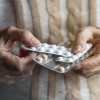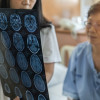Farmakoterapi untuk gangguan mood dan emosional pasca stroke penting dipahami oleh dokter karena sekitar 6-35% pasien pasca stroke mengalami gangguan mood dan emosional. Gangguan dapat berupa depresi pasca stroke, inkontinensia emosi pasca stroke, dan kemarahan pasca stroke.[1,2]
Prevalensi depresi pasca stroke (post-stroke depression atau PSD) mencapai sepertiga dari total kasus selama 5 tahun pertama setelah stroke. Sementara itu, prevalensi inkontinensia emosi pasca stroke (post-stroke emotional incontinence atau PSEI) berkisar antara 6–34% dan prevalensi kemarahan pasca stroke (post-stroke anger atau PSA) berkisar antara 15–35%.[2-5]
Gejala PSEI meliputi ketakutan (terutama takut mengalami serangan stroke berulang dan takut terjatuh), penumpulan emosi, penurunan kemampuan pengenalan emosi, penurunan empati emosi, dan penurunan kontrol ekspresi emosi. Disfungsi serotonik yang berkaitan dengan lesi stroke diduga berhubungan dengan terjadinya PSEI, PSA dan PSD. Selain itu, PSD juga berkaitan dengan faktor genetik dan psikososial.[2,6]
Gangguan mood dan emosional pasca stroke tidak hanya berdampak negatif pada kualitas hidup, prognosis, dan mortalitas, tetapi juga memengaruhi relasi dan kualitas hidup pelaku rawat. Namun, hanya sekitar 20% pasien dengan PSEI, PSA atau PSD mendapatkan terapi. Hal ini disebabkan oleh seringnya gejala tersamar, adanya kekhawatiran akan stigma, atau anggapan bahwa hal tersebut adalah bagian wajar dari penuaan.[1,5-7]
Penelitian Farmakoterapi Gangguan Emosional Pasca Stroke
Secara garis besar, farmakoterapi pada gangguan emosional pasca stroke diberikan pada kasus PSA, apati, atau gangguan kontrol ekspresi emosi. Farmakoterapi yang umum diujicobakan untuk mengatasi PSA adalah selective serotonin reuptake inhibitor (SSRI) atau agen neuroleptik (haloperidol atau antipsikotika atipikal).[6]
Pada kondisi apati, obat yang telah diujicobakan adalah agen dopaminergik, nootropik (nefiracetam), kolinergik, atau stimulan. Sementara itu, untuk gangguan kontrol ekspresi emosi terdapat data studi yang memberikan SSRI (citalopram, fluoxetin, sertralin), antidepresan trisiklik atau TCA (amitriptyline dan nortriptyline), antidepresan tetrasiklik, levodopa, ataupun kombinasi dextromethorphan dengan quinidine.[6,8]
Kualitas bukti ilmiah yang tinggi hanya ditunjukkan pada pemberian obat SSRI, TCA, antidepresan tetrasiklik, dan kombinasi dextromethorphan dengan quinidine pada kondisi gangguan kontrol ekspresi emosi. Sementara itu, pemberian farmakoterapi pada kondisi lainnya menunjukkan variasi kualitas bukti ilmiah sangat rendah hingga rendah, sehingga kesimpulan pasti belum bisa ditarik.[6]
Gangguan kontrol ekspresi emosi sering dikenal sebagai pseudobulbar affect (PBA). Gangguan ini dapat digambarkan sebagai luapan emosi involunter berupa tertawa atau menangis yang tidak berhubungan dengan mood, konteks sosial, atau stimulus yang ada. Pada tahun 2010, terdapat tinjauan sistematis dari Cochrane yang menganalisis 7 uji klinis tentang efek antidepresan (amitriptyline, nortriptyline, citalopram, fluoxetin, dan sertralin) dibandingkan plasebo pada 239 pasien PSA.[6,8]
Dalam tinjauan sistematis tersebut, ada 5 uji klinis yang menunjukkan penurunan hingga 50% pada skor emosi, kesulitan menangis, dan labilitas pada pathological laughter dan crying scale (PLACS) bila menggunakan farmakoterapi. Namun, kelima uji tersebut memiliki rentang confidence interval (CI) yang tinggi. Sementara itu, 2 uji klinis lainnya menunjukkan tidak ada perbedaan bermakna antara grup farmakoterapi dan grup kontrol.[6]
Kombinasi dextromethorphan (DM) 20 mg dan quinidine (Q) 10 mg (disebut DMQ) merupakan satu-satunya obat yang disetujui oleh FDA untuk kondisi PBA. Kombinasi DMQ ini awalnya digunakan untuk kasus PSA pada pasien dengan multiple sclerosis dan gangguan neuron motorik. Namun, penelitian di tahun 2019 terhadap 113 pasien PBA menunjukkan perbaikan keseluruhan (termasuk fungsi harian) serta tingkat keamanan yang baik.[6,8]
DMQ tidak boleh diberikan bersama antidepresan dan agen serotoninergik karena bisa menimbulkan sindrom serotoninergik.[6,8]
Penelitian Farmakoterapi Depresi Pasca Stroke atau PSD
Sekitar 80% kasus PSD dapat didiagnosis dalam 3 bulan pertama pasca stroke. Inisiasi antidepresan <6 minggu pasca stroke pada kasus PSD menunjukkan tingkat recovery yang lebih tinggi daripada inisiasi setelah 7 minggu. Durasi terapi PSD menggunakan antidepresan masih beragam antara 6–12 bulan.[5,9]
Hingga saat ini tidak ada data yang cukup tentang efektivitas dan keamanan mood stabilizer ataupun benzodiazepin untuk kasus PSD. Penelitian dengan stimulan, yaitu metilfenidat, hanya dilakukan pada jumlah sampel yang sedikit dan menunjukkan hasil yang tidak bermakna jika dibandingkan dengan kelompok kontrol. Saat ini juga belum ada rekomendasi tentang jenis antidepresan spesifik yang dapat digunakan untuk kasus PSD.[5]
Suatu meta analisis di tahun 2020 terhadap 51 uji klinis acak menilai efektivitas 9 antidepresan yang sering diresepkan (escitalopram, citalopram, duloxetin, paroxetin, mirtazapin, doxepin, amitriptyline, venlafaxine, dan sertralin) untuk kasus PSD. Hasilnya menunjukkan bahwa escitalopram, mirtazapine, sertralin, citalopram, venlafaxine, dan paroxetin berkaitan dengan penurunan skor total Hamilton Depression Scale (HAMD) yang lebih besar daripada kelompok kontrol selama 2 minggu pertama pemberian.[10]
Dari kesembilan antidepresan dalam meta analisis tersebut, escitalopram ternyata menunjukkan efektivitas tertinggi dan amitriptyline menunjukkan efektivitas terendah. Doxepin monoterapi dianggap tidak berbeda bermakna jika dibandingkan kelompok placebo, sehingga kurang dianjurkan.[10]
Pada minggu ke-4, citalopram menunjukkan efektivitas tertinggi bila dibandingkan 8 antidepresan lainnya. Sementara itu, pada minggu ke-8, mirtazapin menunjukkan respons yang lebih baik, yang lalu diikuti dengan venlafaxin dan escitalopram.[10]
Antidepresan untuk Pencegahan Depresi Pasca Stroke (PSD)
Pemberian SSRI pasca stroke diperkirakan mampu meningkatkan neuroplastisitas. Neuroplastisitas dimediasi oleh pemberian SSRI pasca stroke lewat perbaikan sirkulasi darah serebral, peningkatan neurogenesis di ventrikular subependimal dan di area subgranular girus dentatus hipokampus, serta peningkatan neuroproteksi dengan penurunan jaras inflamasi.[3,11]
Teori tersebut didukung dalam suatu tinjauan sistematik di tahun 2020 yang telah menunjukkan bahwa pemberian antidepresan pada pasien pasca stroke menurunkan risiko PSD hingga 30% jika dibandingkan dengan tidak adanya terapi antidepresan.[12]
Selanjutnya, ada tinjauan sistematis lain di tahun 2021 yang menilai efek pencegahan PSD dengan pemberian antidepresan pada pasien pasca stroke. Terdapat 11 uji klinis acak dengan subjek total 7.089 dan durasi pasca stroke <24 jam hingga maksimal 1 bulan. Antidepresan yang diberikan adalah:
- Golongan noradrenergic and specific serotonergic antidepressant (NaSSA) berupa mirtazapine dan milnacipran
- SSRI berupa sertralin, fluoxetin, dan escitalopram
Serotonin and norepinephrine reuptake inhibitor (SNRI) berupa duloxetin
- Antidepresan tetrasiklik berupa mianserin[3]
Durasi pengamatan dalam uji-uji klinis yang dipelajari dalam tinjauan sistematik tersebut berkisar antara 3–12 bulan. Tujuh dari 11 penelitian membuktikan efektivitas mirtazapin, milnacipran, sertralin, fluoxetin, duloxetin, dan escitalopram untuk pencegahan PSD. Namun, hasil yang berbeda ditunjukkan dalam 4 penelitian lainnya, di mana sertralin, escitalopram, fluoxetin, dan mianserin ternyata tidak begitu efektif mencegah PSD pada pasien pasca stroke.[3,11,13,14]
Mianserin sendiri dikatakan memiliki efek pencegahan PSD yang sangat rendah, sehingga hasil mungkin tersamar dengan grup plasebo. Sementara itu, sertralin dikatakan memiliki efek pencegahan jika diberikan dalam dosis besar hingga 150 mg selama 12 bulan. Efektivitas pencegahan ini tidak tampak pada dosis 50 mg selama pemberian 6 bulan. Hal tersebut berbeda dengan duloxetin dan escitalopram yang dapat dinilai efek pencegahannya setelah pemberian 3 bulan.[3,11,13,14]
Pemberian fluoxetin dengan dosis 20 mg juga menunjukkan hasil yang beragam. Pemberian selama 6 bulan dikatakan mampu menurunkan frekuensi diagnosis PSD, tetapi perbaikan bermakna tidak tampak setelah pemberian 12 bulan.[3,11,13,14]
Kesimpulan
Sekurangnya 6–35% pasien pasca stroke mengalami gangguan mood dan emosional. Gangguan dapat berupa depresi pasca stroke (PSD), inkontinensia emosi pasca stroke (PSEI), dan kemarahan pasca stroke (PSA). Akan tetapi, hingga saat ini belum ada pedoman yang menentukan waktu inisiasi farmakoterapi, durasi farmakoterapi, dan jenis farmakoterapi untuk gangguan mood dan emosional pasca stroke.[3-8,10,12-14]
Kombinasi DMQ (dextromethorphan dan quinidine) merupakan satu-satunya obat yang disetujui FDA untuk gangguan kontrol ekspresi emosi (pseudobulbar affect atau PBA). Namun, data untuk terapi PBA juga masih minimal.
Bukti tentang pemberian antidepresan seperti amitriptyline, nortriptyline, citalopram, fluoxetin, dan sertralin pada kasus PSA dinyatakan menunjukkan respons yang cenderung positif, tetapi memiliki rentang CI yang tinggi. Selain itu, terdapat data lain yang menunjukkan hasil tidak berbeda bermakna dibanding kelompok kontrol.[6]
Perbaikan yang bermakna ditunjukkan pada penggunaan antidepresan untuk kasus PSD. Escitalopram dapat menjadi pilihan pertama jika memerlukan perbaikan cepat. Sementara itu, mirtazapine menunjukkan perbaikkan fungsi yang lebih bermakna setelah penggunaan 8 minggu.[5,10]















